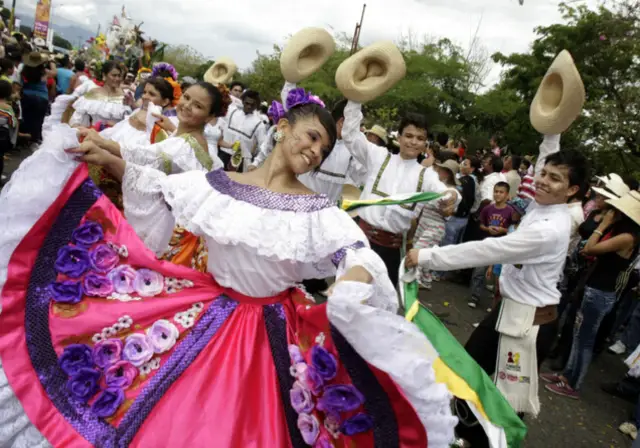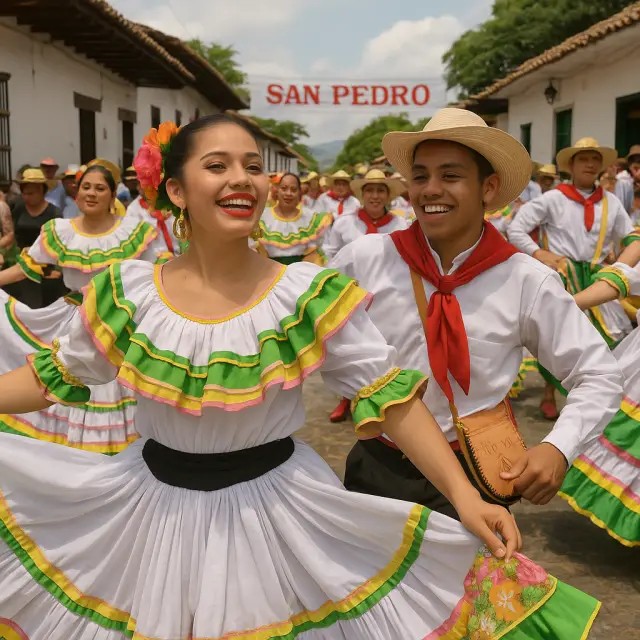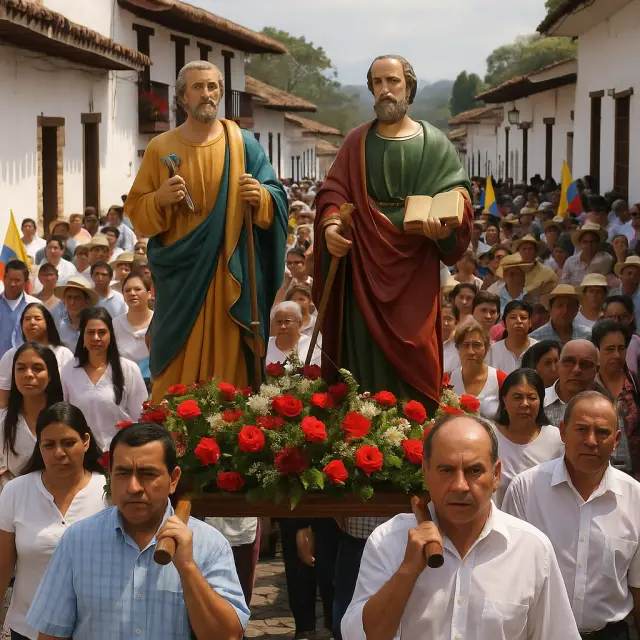June 29th is an emblematic date in Colombia 's liturgical and cultural calendar. This day commemorates the solemnity of Saints Peter and Paul , two of the most important apostles of Christianity, whose work was key to the spread of the Catholic faith throughout the world. Although it is a celebration of religious origin, in Colombia it has transcended the spiritual to become an occasion of great folklore, cultural, and tourist significance.
Regions such as Huila, Tolima, and the Colombian Caribbean celebrate this holiday with popular fervor, organizing mass events that include religious processions, dance festivals, contests, food fairs, and community gatherings. This fusion of Catholic tradition and local culture makes June 29th an opportunity to highlight regional identity, strengthen historical roots, and promote tourism in the country.

Religious origin and meaning of Saint Peter and Saint Paul
Who was Saint Peter?
Saint Peter, also known as Simon Peter, was one of Jesus's closest disciples. According to the Gospels, he was the first to recognize him as the Messiah and received from him the keys to the Kingdom of Heaven, symbolizing his leadership of the nascent Church. Peter was considered the first Pope by the Catholic Church, and his role as the visible head of early Christianity makes him a figure of great spiritual significance. He was martyred in Rome during the persecution of Emperor Nero, being crucified upside down at his own request, as he did not consider himself worthy of dying like his teacher. His tomb is located in St. Peter's Basilica in the Vatican, one of the holiest sites in Christianity.
Who was Saint Paul?
Saint Paul, formerly known as Saul of Tarsus, was a persecutor of Christians who converted after a mystical experience on the road to Damascus. From that moment on, he dedicated his life to preaching the Gospel among the Gentiles, founding numerous Christian communities in Asia Minor and Europe. His legacy is present in his epistles, texts that form part of the New Testament and are fundamental to Christian doctrine. Paul was also executed in Rome, but unlike Peter, he died by beheading, reflecting the distinction of being a Roman citizen. His figure is a symbol of conversion, mission, and commitment to the faith.

Why is it celebrated on June 29th?
June 29th was established by the Catholic Church as the day to jointly honor Saints Peter and Paul because, according to tradition, both were martyred in Rome during the same period. This date has been officially recognized since the time of the Roman Empire and is considered one of the most important solemnities of the Christian liturgical calendar. In Colombia, this celebration was adopted during the colonial era, and over the centuries it has gained strength in regions where popular religiosity is deeply rooted. The dual nature of this commemoration—spiritual and cultural—has kept it as one of the most representative holidays on the national calendar.
Holiday and long weekend in Colombia
In Colombia, although June 29th is the official date for the celebration of Saints Peter and Paul, the holiday is not always celebrated on that same day. Thanks to the Emiliani Law (Law 51 of 1983), which seeks to promote tourism and work holidays, religious holidays that do not have a fixed date are moved to the nearest Monday. This allows for long weekends and extended weekends, benefiting sectors such as the hotel, restaurant, and transportation industries. For example, if the 29th falls on a Thursday or Friday, the holiday is moved to the following Monday. In 2025, since it falls on a Sunday, the holiday will be Monday, June 30th , thus offering a long weekend for Colombians.
Popular celebrations in Colombia
Tolima and Huila: folklore tradition
In Tolima and Huila , the celebration of Saint Peter and Saint Paul takes on a majestic character. The renowned Bambuco Folklore Festival and National Pageant takes place there, a cultural event that combines native dances such as the Sanjuanero Huilense, the Rajaleña, and other rhythms from the Andean interior. This festival has roots that blend indigenous, African, and Spanish elements and is considered a National Cultural Heritage. The troupes parade through the streets of Neiva, Ibagué, and other cities, while the candidates for the national pageant represent their departments with traditional costumes and artistic performances. There are also concerts, parades, gastronomy contests, and academic events related to Colombian cultural identity.
Neiva and Huila
The city of Neiva, capital of the Huila department, is the epicenter of the San Pedro festivities . During this time, hotel occupancy can reach levels above 90%, and visitors enjoy a varied cultural agenda. Highlights include folkloric parades, the election of the Bambuco Queen, culinary showcases such as Huila barbecue, tamales, and traditional drinks like chicha and guarapo. Ancestral rituals, craft fairs, and sports competitions are also held. The celebrations last for more than a week, making the city a must-see destination on the Colombian tourist calendar.
Other regions
In other regions of the country, such as the Caribbean Coast, Antioquia, and the Coffee Region, Saint Peter and Saint Paul are also celebrated, albeit with more local expressions. In some coastal towns, maritime processions are held with religious images, in which rivers and the sea are blessed as symbols of fertility and prosperity. In Antioquia, rural parishes organize novenas, serenades, and traditional food competitions. Even in Bogotá and other large cities, communities organize liturgical and cultural events, keeping alive this religious tradition that unites generations.

Cultural and religious activities
The activities surrounding June 29th range from religious ceremonies to mass cultural performances. On the religious side, parishes celebrate solemn masses , novenas, and processions in honor of the apostles. The faithful often carry candles, banners, and commemorative vestments, and in some places, scenes from the lives of Peter and Paul are dramatized. On the cultural side, highlights include folk music festivals, dance group performances, craft fairs, traditional sports competitions, and food fairs. Typical dishes such as suckling pig, sancocho, fried mojarra, tamales, empanadas, and drinks such as aguardiente and canelazo are prepared. This diversity of expressions makes the festival an opportunity for encounter, remembrance, and the celebration of the collective.
FAQ
1. Is June 29th always a holiday in Colombia?
Yes, Saints Peter and Paul are celebrated. However, the holiday can be moved to the following Monday under the Emiliani Law, to facilitate long weekends and promote tourism.
2. What is the difference between Saint Peter and Saint John?
Saint John's Day is celebrated on June 24th and is associated with water and fire rituals, while Saints Peter and Paul are honored on the 29th, with greater emphasis on ecclesiastical life.
3. Where are the most important festivals celebrated?
The most notable ones take place in Neiva (Huila) and in cities in Tolima, where the Bambuco Festival is the central axis of the celebration.
4. What activities can I do during these holidays?
Participate in processions, attend folk concerts, sample traditional cuisine, watch parades, and enjoy pageants and parades.
5. What typical dishes are consumed during these dates?
The most notable dishes are Huila tamales, asado (roast), lechona (suckling pig), sancocho (steamed pork), arepas, empanadas, and drinks such as aguardiente and masato.
Live the tradition of Saint Peter and Saint Paul
June 29th in Colombia is much more than a holiday: it's a living expression of faith, tradition, and culture . From the spirituality of the masses to the joy of the festivals, this celebration brings together entire communities to pay homage to two pillars of Christianity. It also boosts tourism , invigorates the local economy, and strengthens the country's cultural ties. If you have the opportunity, don't hesitate to join the celebrations of this significant date: whether in Neiva, Ibagué, or any other corner of Colombia, you'll feel the magic of a festival that honors history and celebrates life.
